
Are you worried about ticks and the potential risk of Lyme disease? Understanding the early signs, like the distinctive rash, can be your first line of defense. This article will guide you through the visual signs of a Lyme disease rash, providing you with the additional knowledge to take swift action. We’ll look into how to spot this rash. We’ll also cover the importance of finding it early. Doing so can greatly cut the risk of long-term problems. So, if you’re planning a hike or just enjoy the great outdoors, arm yourself with the knowledge to stay safe.
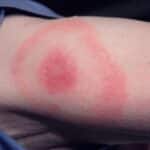
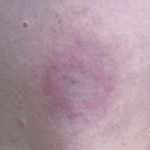
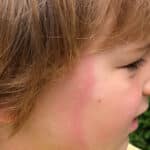
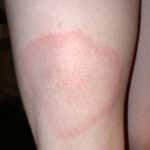

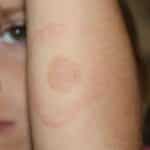
Key Takeaways
The Erythema Migrans (EM) rash or the “classic Lyme rash” typically appears three to thirty days following exposure to an infected tick. It is characterized by a red, expanding blotch that may develop a “bull’s-eye” appearance.
The “bull’s-eye” rash is not always present. It can look different. Some have faint borders, different colors, or many rashes.
The Lyme disease rash looks like other rashes. It can be confused with conditions like ringworm and spider bites. Also, with cellulitis, eczema, or STARI.
It is important to understand the key differences between a Lyme disease rash and other similar-looking conditions. For example, the rash in Lyme disease gradually expands, while in ringworm it is a fixed-size patch. Also, Lyme disease lacks the intense itching and crusting of eczema. Knowing these differences can help you identify them accurately.
If a tick bite or possible Lyme disease rash is suspected, seek medical help right away. This is to ensure proper diagnosis and treatment.
Have Mold Illness or suspect you do?
We have helped thousands of people restore their health and quality of life by diagnosing and treating their Mold Illness
Lyme disease, spread by the bite of an infected tick, often manifests through distinct skin rashes. It’s crucial for you to understand these rashes. Early identification can greatly cut the risk of long-term problems.
The Erythema Migrans (EM) rash typically appears from three to 30 days after exposure to an infected tick, and develops in approximately 70-80% of infected individuals. The EM rash, also known as the “classic Lyme Rash,” is a red blotch that expands. It often clears in the center to form a “bull’s-eye.” But, one must note, it’s not always the norm and the rash can appear uniformly red.
Likewisely, the bullseye rash is a hallmark of Lyme disease. It may start as a solid red rash or blotch (sometimes mistaken for a spider bite). But, as it grows, it takes on the circular “bull’s-eye” appearance. The red outer ring surrounds a clear zone, which, in turn, encircles an area of clear skin or mild redness in the center. Also, remember, this rash does not appear in all cases. It is only in around 20-30% of infections.
Different Lyme disease rashes exist. They have faint or different coloring, faint borders, different shapes, many rashes, and even a crusted center. This change in appearance adds to the challenge of quick identification. It also shows the importance of medical help if you think you have Lyme disease – book a call with us.
Being consistently informed and vigilant can lead to quick identification. It can also lead to early treatment of Lyme disease. Understanding the various forms of Lyme disease rashes is key. If you notice a tick bite or any odd rashes after outdoor activities, especially in tick-prone areas, seek medical help right away.
Take our In-Depth Get Well Quiz!
Distinguishing a Lyme disease rash from other skin conditions ensures you get the right treatment. Clarity hampers, though, considering many of these rashes resemble those of different conditions. For a layperson, misdiagnosis becomes a risk. So, this section aims at providing you with an understanding of common conditions often mistaken for Lyme disease rash.
Likewise, many medical conditions have rashes. Lyme disease rash is similar to several skin conditions. Ringworm, for example, a fungal infection that frequently makes a red rash can be confused with the ‘bull’s-eye’ of Lyme disease. Spider bites and cellulitis, an infection affecting the skin’s deeper layers, also add to this list. So do eczema, a chronic skin disorder.
Also, another tick-borne disease is Southern Tick-Associated Rash Illness (STARI) also can give a rash very similar to Lyme disease. This similarity reinforces the need for accurate identification. Misidentification can have serious consequences. It can lead to wrong treatment. For Lyme disease, this may cause long-term health issues.
By emphasizing distinct traits, one can see the differences between Lyme disease rash and those of other conditions. This makes it easier. In Lyme disease, the rash shows up 3 to 30 days after a tick bite. It often, but not always, has a ‘bull’s-eye’ pattern. It expands slowly over days and can reach up to 12 inches (30 centimeters) across. The central part of the rash may clear as it enlarges, resulting in a ring-like appearance.
In contrast, conditions like ringworm cause patches. The patches may be scaly, inflamed, and itchy. But, they do not grow. Cellulitis presents as a red, swollen area that’s tender and hot to the touch, the skin may dimple or, conversely, appear shiny. Finally, the eczema rash is usually itchy and dry. It can crack and ooze, and crust. These features are not normally linked with Lyme disease.
Understanding these key differences will help you identify a Lyme disease rash. If you suspect a tick bite or a Lyme disease rash, be sure to consult a healthcare professional. They will give you the right tests. Remember, spotting the early signs quickly improves your chance for effective treatment. It also improves your chance for full recovery.
You now have the knowledge. It lets you tell Lyme disease rash from other skin conditions. Early detection is crucial as it dramatically increases odds for successful Lyme treatment. Recognizing the unique bullseye rash helps you seek medical help promptly. This is important after exposure in tick-prone areas. It’s not just about identifying a rash – it’s about getting the right diagnosis and treatment quickly.
You can learn more about Lyme Disease and the impact below:
Free Lyme/Mold Webinar: "Why Am I Still Sick?"
Have Lyme Disease or suspect that you do?
We have helped thousands of
people restore their health
and quality of life by diagnosing
and treating their Lyme Disease.
“Dr. Mueller’s approach to medicine is refreshing! There is only so much you can do with western medicine and in my life I was needing a new approach. By addressing the whole body, nutritional diet factors, environmental factors, blood work, and incorporating ideas I had not previously known, I was able to break through with my conditions. I am not only experiencing less pain in my life, but through the process of healing guided by Dr. Diane Mueller, I am now happy to say I have more consciousness surrounding how I eat, what to eat and when things are appropriate. Living by example Dr. Mueller has a vibrancy that makes you want to learn and know more about your body and overall health. I highly recommend her to anyone looking for new answers, a new approach to health, or in need of freedom from pain and limitations.”
-Storie S.
Kihei, HI
Lyme Disease and Mold Illness are Often Misdiagnosed as Fibromyalgia, Chronic Fatigue, Depression,
or Other Illnesses
Have Lyme Disease or suspect you do?
